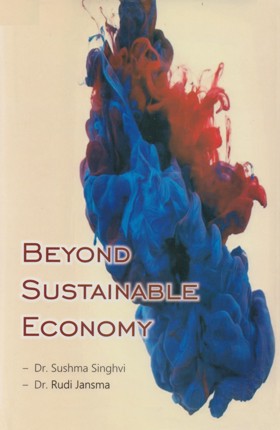Helena Petrovna Blavatsky[1], [2]
Few persons are capable of appreciating the truly beautiful and esthetic; fewer still of revering those monumental relics of bygone ages, which prove that even in the remotest epochs mankind worshipped a Supreme Power, and people were moved to express their abstract conceptions in works which should defy the ravages of Time.
According to recent Russian papers, the Moscow arch-millionaire, Kokoref, with his Tiflis [Tbilisi] partner, the American Croesus, Mirzoef, is desecrating and apparently about to totally destroy perhaps the oldest relic in the world of Zoroastrianism the 'Attesh-Gag' of Baku[3].
Few foreigners, and perhaps as few Russians, know anything of this venerable sanctuary of the worshippers around the Caspian Sea. About twenty versts[4] from the small town of Baku in the valley of Absharon, and among the barren, desolated steppes of the shores of the Caspian, there stands - alas! rather stood, but a few months ago - a strange structure, something between a mediaeval cathedral and a fortified castle. It was built in unknown ages, and by builders as unknown. Over an area of somewhat more than a square mile, a tract known as the 'Fiery Field,' upon which the structure stands, if one but digs from two to three inches into the sandy earth, and applies a lighted match, a jet of fire will stream up, as if from a spout. A bluish flame is seen to arise there, but this fire does not consume, "and if a person finds himself in the middle of it, he is not sensible of any warmth." The building is carved out of one solid rock. It comprises an enormous square enclosed by crenellated walls, and at the centre of the square, a high tower also rectangular resting upon four gigantic pillars. The latter were pierced vertically down to the bed-rock and the cavities were continued up to the battlements where they opened out into the atmosphere; thus forming continuous tubes through which the inflammable gas stored up in the heart of the mother rock were conducted to the top of the tower. This tower has been for centuries a shrine of the fire-worshippers and bears the symbolical representation of the trident called teersoot. All around the interior face of the external wall, are excavated the cells, about twenty in number, which served as habitations for past generations of Zoroastrian recluses. Under the supervision of a High Mobed, here, in the silence of their isolated cloisters, they studied the Avesta, the Vendidad, the Yaśna - especially the latter, it seems, as the rocky walls of the cells are inscribed with a greater number of quotations from the sacred songs. Under the tower-altar, three huge bells were hung. A legend says that they were miraculously produced by a holy traveler, in the tenth century during the Muslim persecution, to warn the faithful of the approach of the enemy.
But a few weeks ago, and the tall tower-altar was yet ablaze with the same flame that local tradition affirms had been kindled thirty centuries ago. At the horizontal orifices in the four hollow pillars burned four perpetual fires, fed uninterruptedly from the inexhaustible subterranean reservoir. From every merlon on the walls, as well as from every embrasure flashed forth a radiant light, like so many tongues of fire; and even the large porch overhanging the main entrance was encircled by a garland of fiery stars, the lambent lights shooting forth from smaller and narrower orifices. It was amid these impressive surroundings, that the 'Guebre' or rather the Behedin (followers of the true faith) recluses used to send up their daily prayers, meeting under the open tower-altar; every face reverentially turned toward the setting sun, as they united their voices in a parting evening hymn. And as the luminary - the 'Eye of Ahura-mazda' - sank lower and lower down the horizon, their voices grew lower and softer, until the chant sounded like a plaintive and subdued murmur... A last flash and the sun is gone; and, as darkness follows daylight almost suddenly in these regions, the departure of the Deity's symbol was the signal for a general illumination, unrivalled even by the greatest fire-works at regal festivals. The whole field seemed nightly like one blazing prairie....
Till about 1840, 'Attesh-Gag' was the chief rendezvous for all the Fire-worshippers of Persia. Thousands of pilgrims came and went; for no true Behedin could die happy unless he had performed the sacred pilgrimage at least once during his life-time. A traveler - Koch - who visited the cloister about that time, found in it but five Zoroastrians, with their pupils. In 1878, about fourteen months ago, a lady of Tiflis, who visited the Attesh-Gag, mentioned in a private letter that she found there but one solitary hermit, who emerges from his cell but to meet the rising and salute the departing sun.
And now, hardly a year later, we find in the papers that Messrs. Kokoref and Co., are busy erecting on the Fiery Field enormous buildings for the refining of petroleum! All the cells but the one occupied by the poor old hermit, half ruined and dirty beyond all expression, are inhabited by the firm's workmen; the altar over which blazed the sacred flame, is now piled high with rubbish, mortar and mud, and the flame itself turned off in another direction. The bells are now, during the periodical visits of a Russian priest, taken down and suspended in the porch of the superintendent's house; heathen relics being as usual used - though abused - by the religion which supplants the previous worship. And, all looks like the abomination of desolation..
"It is a matter of surprise to me," writes a Baku correspondent in the St. Petersburg Vjedomosti, who was the first to send the unwelcome news, "that the trident, the sacred teersoot itself, has not as yet been put to some appropriate use in the new firm's kitchen...! Is it then so absolutely necessary that the millionaire Kokoref should desecrate the Zoroastrian cloister, which occupies such a trifling compound in comparison to the space allotted to his manufactories and stores? And shall such a remarkable relic of antiquity be sacrificed to commercial greediness which can after all neither lose nor gain one single rouble by destroying it?"
It must apparently, since Messieurs Kokoref and Co. have leased the whole field from the Government, and the latter seems to feel quite indifferent over this idiotic and useless Vandalism. It is now more than twenty years since the writer visited for the last time Attesh-Gag. In those days besides a small group of recluses it had the visits of many pilgrims. And since it is more than likely that ten years hence, people will hear no more of it, I may just as well give a few more details of its history. Our Parsee friends will, I am sure, feel an interest in a few legends gathered by me on the spot.
There seems to be indeed a veil drawn over the origin of Attesh-Gag. Historical data are scarce and contradictory. With the exception of some old Armenian chronicles which mention it incidentally as having existed before Christianity was brought into the country by Saint Nina during the third century, there is no other mention of it anywhere else so far as I know.
Tradition informs us - how far correctly is not for me to decide - that long before Zarathustra, the people, the 'Behedin' recognized Mithra, the Mediator, as their sole and highest God - who included within himself all the good as well as the bad gods.
Mithra represents the two natures of Ormazd and Ahriman combined, and the people feared him, whereas, they would have had no need of fear, but only could have loved and revered him as Ahura-Mazda - Mithra without the Ahriman element in him.
One day as the god, disguised as a shepherd, was wandering about the earth, he came to Baku, then a dreary, deserted sea-shore, and found an old devotee of his quarrelling with his wife. Upon this barren spot wood was scarce, and she would not give up a certain portion of her stock of cooking fuel to be burned upon the altar. So the Ahriman element was aroused in the god and, striking the stingy old woman, he changed her into a gigantic rock. Then, the Ahura-Mazda element prevailing, he, to console the bereaved widower, promised that neither he, nor his descendants, should ever need fuel any more, for he would provide such a supply as should last till the end of time. So he struck the rock again and then struck the ground for miles around, and the earth and the calcareous soil of the Caspian shores were filled up to the brim with naphtha. To commemorate the happy event, the old devotee assembled all the youths of the neighborhood and set himself to excavating the rock which was all that remained of his ex-wife. He cut the battlemented walls, and fashioned the altar and the four pillars, hollowing them all to allow the gases to rise up and escape through the top of the merlons. The god Mithra upon seeing the work ended, sent a lightning flash, which set ablaze the fire upon the altar, and lit up every merlon upon the walls. Then, in order that it should burn the brighter, he called forth the four winds and ordered them to blow the flame in every direction. To this day, Baku is known, under its primitive name of "Baadey-ku-ba," which means literally the gathering of winds.
According to another legend, the devotees of Mithra worshipped at his shrines, until Zarathustra, descending from heaven in the shape of a 'Golden Star,' transformed himself into a man, and began teaching a new doctrine. He sung the praises of the One but Triple god - the supreme Eternal, the incomprehensible essence 'Zervana-Akerene,' which emanating from itself 'Primeval Light,' the latter in its turn produced Ahura-Mazda.
With the exception of the Bombay community of Parsees, Fire-worshippers are, then, to be found but in the two places before mentioned, and scattered around Baku. The Parsees are considered by all the travelers as well as Anglo-Indians as the most intelligent, industrious and well-behaved community of the native races, the fire-worshippers of Kerman and Yezd bear a very high character among the Persians, as well as among the Russians of Baku. Uncouth and crafty some of them have become, owing to long centuries of persecution and spoliation; but the unanimous testimony is in their favor and they are spoken of as a virtuous, highly moral, and industrious population. 'As good as the word of a Guebre' is a common saying among the Kurds, who repeat it without being in the least conscious of the self-condemnation contained in it.
Helena Petrovna Blavatsky (1831-1891), of Ukraine, was the founder of The Theosophical Society in New York in 1875.
Baku, the capital of Azerbaijan, now of some four million inhabitants, is a city founded upon oil, for to its inexhaustible founts of naphtha it owes its very existence, its maintenance, its prosperity.... At present Baku produces one-fifth of the oil that is used in the world, and the immense output in crude petroleum from this single city far surpasses that in any other district where oil is found. Verily, the words of the Scriptures find illustration here: 'the rock poured me out rivers of oil.
-Oil is in the air one breathes, in one's nostrils, in one's eyes, in the water of the morning bath (though not in the drinking water, for that is brought in bottles from distant mineral springs), in one's starched linen everywhere. This is the impression one carries away from Baku, and it is certainly true in the environs.
-By the beginning of the 20th century almost half of world production was being extracted in Baku. The oil boom contributed to the massive growth of Baku. The first oil well was mechanically drilled in the Bibi-Heybat suburb of Baku in 1846, though a number of hand-dug wells predate it. Large-scale oil exploration started in 1872, when Russian imperial authorities auctioned the parcels of oil-rich land around Baku to private investors. The pioneer of oil extracting from the bottom of the sea was Polish geologist Witold Zglenicki. Soon after that Swiss, British, French, Belgian, German, Swedish and American investors appeared in Baku. An industrial oil belt, better known as Black City, was established near Baku.
 Dr. Rudi Jansma
Dr. Rudi Jansma
 Helena Petrovna Blavatsky
Helena Petrovna Blavatsky
